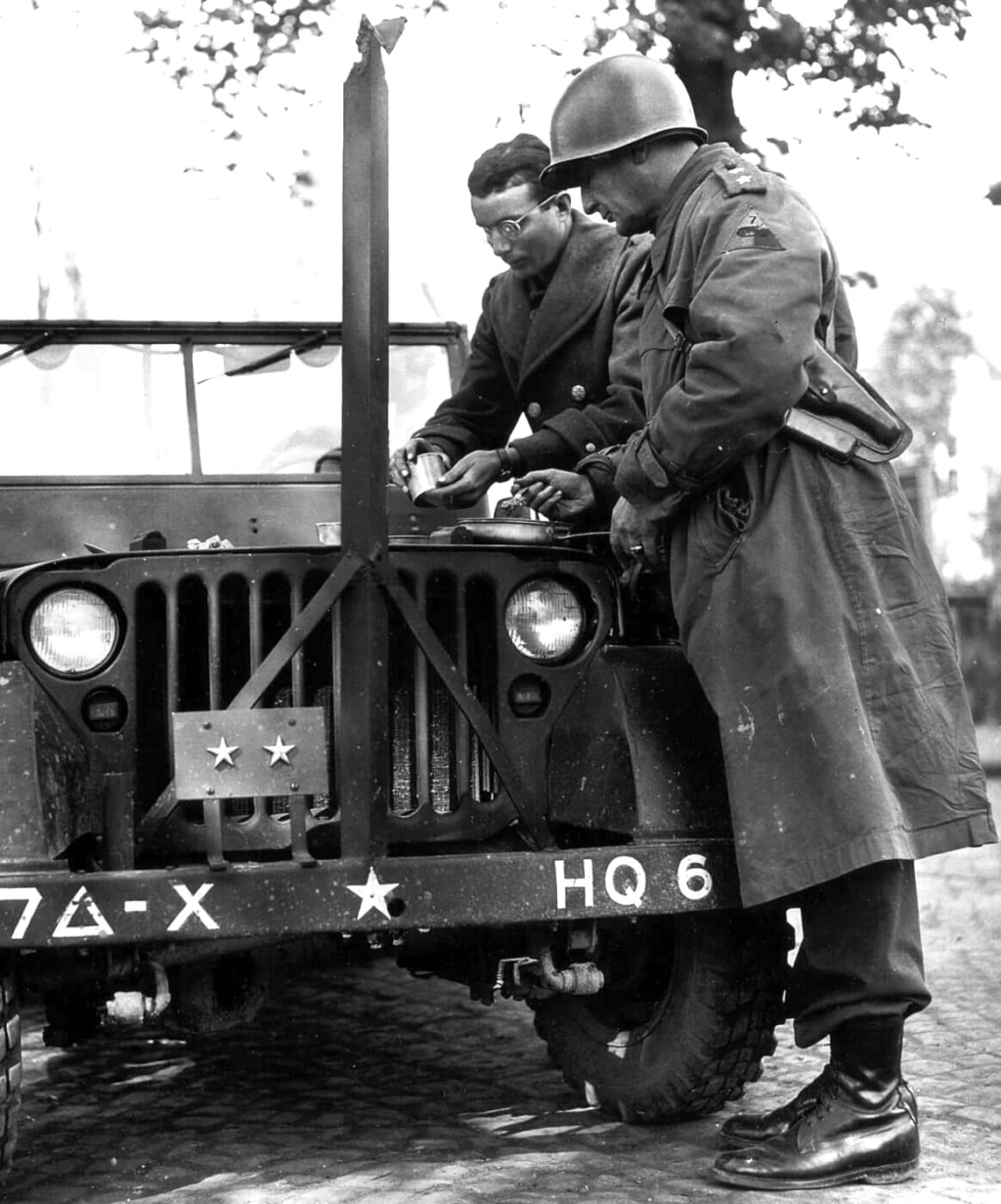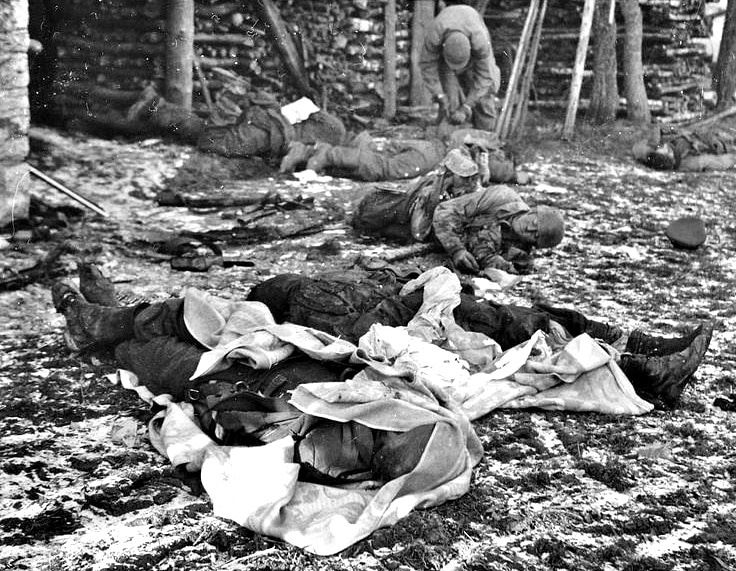Those elements which were cut off east of town were ordered to attack through the town or north of it to join the forces which were establishing a new defensive line. Officers were established at control points west of the town to collect stragglers and to place units in a defensive position as they got back within the friendly screen. During the time this concerted drive was being made on the front, the troops on the northern flank were not heavily engaged, although there was a definite threat in the Ober Emmels-Nieder Emmels area. It was planned to anchor a defense west of St Vith on this still substantial north flank and hold there. The center of the defensive line (from Hünningen to the St Vith-Wallerode road) was to swing back to the west of St Vith and establish a line for elements east of the town to fall back through. This was accomplished and most of the troops were brought out as units. All through the night of Dec 21/22, stragglers were coming back from the troops which had been overrun east of St Vith. Officer control posts had been set up on all roads to intercept these men and send them to the Hinderhausen area. This was done and by early forenoon of Dec 22, about 150 stragglers had been gathered up.
The situation on the right flank of the division became critical on Dec 21. CCB-9-AD, requested assistance, and Task Force Lindsey, which had been held in division reserve, was ordered to Galhausen to reinforce that unit. This assistance was sufficient to restore the situation, and Task Force Lindsey was returned to its former mission of reserve at 1000. On the left flank of CCB-7-AD, CCA-7-AD maintained its position in and around Poteau throughout the day. A strong attack, which included tanks and artillery, was successfully repulsed around 1330. Strong patrols on both sides were active during the day. The enemy established an effective ambush in some thick woods southeast of Poteau on the St Vith-Poteau road. Before the ambush was discovered, the enemy was successful in capturing the occupants of eight peeps and one light tank which had been knocked out. Personnel included such key officers as the Executive Officer, CCA; Liaison Officer, CCA; Executive Officer and Adjutant, 48-AIB; and others. Upon discovery, the enemy abandoned its ambush, and the key road was again opened for friendly traffic. In 2000, another strong hostile attack, supported by heavy mortar, machine gun, and artillery fire, was repulsed. Anticipating the possibility of CCR’s being unable to hold the present position, Gen Clarke had initiated recon on the road leading to the west, through Hinderhausen and Commanster to Vielsalm, a possible avenue of withdrawal. This road was in poor condition and for the most part, passed through a forest. Engineers and artillerymen had been put to work on critical and impassable spots, but even with this improvement passage over this road was not easy.
EVENTS OF DECEMBER 22
The Germans continued to attack with infantry and tanks. At 0200, the 928.Grenadier-Battalion attacked Rodt from the rear. The enemy widened this penetration and at 1135, Rodt was captured, splitting CCA and CCB. The nine-hour battle for Rodt was a grim affair in which personnel from every possible source-cooks, drivers, and radio operators were employed to augment the defense in a desperate effort to prevent the enemy from driving a deeper wedge between the two combat commands. The loss of Rodt necessitated CCB’s pulling back its left flank to protect Hinderhausen, a key position on the emergency exit route to Commanster and Vielsalm.
By dark, the line was established again and was strengthened by the addition of the 17-TB (-) on the south flank of CCB-7-AD to tie in with CCB-9-AD. Contact with CCA on the northwest was lost. At 0700, the command post of CCB was moved to Commanster. During this day all unessential vehicles were sent to the rear. By nightfall, the line was being held with the 87-CRS, Col Boylan commanding, on the left; the 31-TB, Col Erlenbusch commanding, in the center; the 17-TB, Col Wemple commanding, on the south. The boundary between the 31-TB and the 17-TB was the railroad line running southwest from St Vith. At 1845, enemy tanks and infantry attacked along the railroad towards Krombach. Infantry broke through and occupied the town. Most of Col Wemple’s force was able to fight its way out the next morning. CCB-9-AD was also receiving a heavy attack at this time and was being slowly pushed back toward Braunlauf. It held on to its contact with CCB-7-AD, pivoting back on Gen Clarke’s right flank and preventing an attempt of the enemy to separate the two combat commands.
At Poteau to the left rear of CCB-7-AD, CCA-7-AD was receiving increasing pressure from the enemy, who was continuing his attempts to outflank the right of CCA. Meanwhile, the enemy on the north struck heavily at 2215 but was driven off. A measure of the bitterness of the fighting on all fronts is indicated by the following extract from the personal reports of members of Baker Co of Col Robert C. Rhea’s 23-AIB: on Friday, the company trains were moved to the west of Krombach. During the morning the men walked back cross-country to a new line which was set up about 1000 yards to the east of Krombach. This line had no depth, and as Capt Britton pointed out ‘once the line was pierced, it was finished’. At the railroad underpass, about 1000 yards northeast of Krombach, a bazooka man and a machine-gun squad were posted. They wanted to mine the underpass, but no mines or explosives were available. The 81-MM mortars of Baker 23-AIB were in position in Krombach, where they fired 600 rounds in 20 minutes and broke the base plates which were welded to the floor of the half-track.
At about 1700, strong enemy combat patrols began coming along the railroad embankment, and tanks came toward the underpass. The bazooka man fired at the tanks, and when the bazooka round bounced off the front, he withdrew. Capt Britton had just come up toward the front and was warming his feet in an oven when the enemy burst into his position. Some of the men pulled back to the north until they ran into tanks of Dog 31-TB; these men rode out with those tanks. The remainder of the company fell back to the motor park in Krombach where the half-tracks were gassing. Late Friday night, these half-tracks moved to Vielsalm where they met the remainder of the company the next morning. Capt Britton said there were men from almost every conceivable unit on the vehicles.
Back at the line, some men remained with another unit which held fast and fought it out. Our artillery and mortar fire worked up and down the railroad track. One Baker 23-AIB mechanic, T/5 Robert Cutts, had a radio with which he called back to the FO giving him the necessary adjustments in the artillery fire. These men also finally pulled back from the line when the 17-TB moved out, and many of them rode the tanks out of the area.
The pressure continued to increase along the entire front; and, as the 7-AD shortened its lines and again regrouped, German infantry and tanks pressed strongly on all positions. Practically the entire division area was now being engaged by long-range artillery fire. In the north, the enemy in strength was along the east bank of the Salm River from east of Trois-Ponts to Grand-Halleux, and in the south along the high ground south of the highway running west from Salmchâteau. This meant that the remainder of the 106-ID, CCB-9-AD, the 14-CG, some Corps troops, including artillery which had been attached to the 7-AD, and the entire 7-AD with attachments, less the trains, were left east of the Salm River; all units were short of supplies and were completely fatigued from five or more days and nights of continuous fighting. There was only one sure exit route, a secondary road running west from Vielsalm; and one probable alternate route, the road Salmchâteau Joubieval Lierneux.
As the position was obviously untenable, Montgomery in a message to Gen Hasbrouck, and its conglomeration of units, ordered a withdrawal: You have accomplished your mission, a mission well-done. It is time to withdraw. All unessential vehicles were withdrawn at once, followed by part of the artillery, which began displacing rearward about midnight. CCB-9-AD was scheduled to be the first unit to withdraw, but their commanding general advised Gen Hasbrouck that they were engaged with the enemy and the muddy condition of the roads and fields was such that an immediate withdrawal would be unfeasible. It was necessary to postpone the initial time for withdrawal, as CCB-7-AD was also heavily engaged with the enemy. At the same time, the enemy was building up strong forces in front of the 82-A/B, west of Salmchâteau.



















